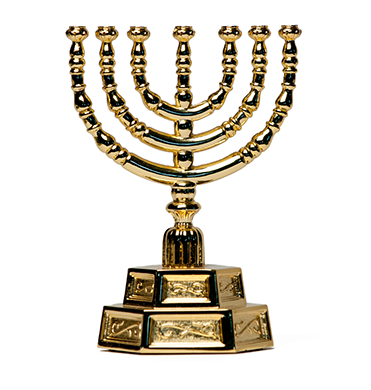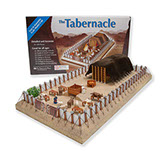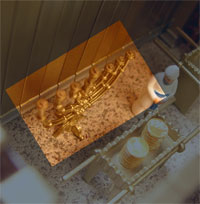<< Previous: Laver (Basin)
Next: Table of Showbread >>
The Menorah (Lampstand)
After washing their hands and feet at the laver, the priests could enter the Holy Place, which was the first room in the tent of the tabernacle. There were three pieces of furniture in the Holy Place: the menorah, the table of showbread and the golden altar of incense.
The menorah, also called the “golden lampstand” or “candlestick,” stood at the left side of the Holy Place. It was hammered out of one piece of pure gold. Like for the laver, there were no specific instructions about the size of the menorah, but the fact that it was fashioned out of one piece of pure gold would have limited its size.
The lampstand had a central branch from which three branches extended from each side, forming a total of seven branches. Seven lamps holding olive oil and wicks stood on top of the branches. Each branch looked like that of an almond tree, containing buds, blossoms and flowers. The priests were instructed to keep the lamps burning continuously.
“The Lord said to Moses, ‘Command the Israelites to bring you clear oil of pressed olives for the light so that the lamps may be kept burning continually. Outside the curtain of the Testimony in the Tent of Meeting, Aaron is to tend the lamps before the Lord from evening till morning, continually.’” (Leviticus 24:1-3)

Purchase a Tabernacle Model Kit
A great visual aid for teaching about the tabernacle with adults and children.

The lampstand was the only source of light in the Holy Place, so without it, the priests would have been moping around in the dark. The light shone upon the table of showbread and the altar of incense, enabling the priests to fellowship with God and intercede on behalf of God’s people. Just as the lampstand was placed in God’s dwelling place so that the priests could approach God, Jesus, the “true light that gives light to every man” (John 1:9) came into the world so that man could see God and not live in spiritual darkness anymore. Jesus said:
“I am the light of the world. Whoever follows me will never walk in darkness, but will have the light of life.” (John 8:12)
“I have come into the world as a light, so that no one who believes in me should stay in darkness.” (John 12:46)


Jesus is represented by the main branch of the lampstand, and we as believers are represented by the six branches that extend from original branch. Having believed, we are now living as “children of light” (Ephesians 5:8) who draw our source of light from Jesus, the true light. Jesus calls us “light of the world” and commands us to “let your light shine before men, that they may see your good deeds and praise your Father in heaven” (Matthew 5: 14, 16). Not only so, but the branches serve as a picture of Jesus’ description of our relationship with him: “I am the vine, you are the branches … apart from me you can do nothing” (John 15:5).
Two other significant symbols that can be seen from include the fact that it was made of pure gold (not gold plated) and had seven branches. Pure gold is a representation of the deity and perfection of Jesus Christ, and seven is the number of completeness in the Bible. The believer is made complete by the perfection of Christ.
<< Previous: Laver (Basin)
Next: Table of Showbread >>
What is the Tabernacle of Moses?
- Diagrams of the Tabernacle and Basic Layout
- The Gate
- The Brazen Altar
- The Laver
- The Menorah
- The Table of Showbread
- The Golden Altar of Incense
- The Ark of the Covenant and Atonement Cover
Why Study the Tabernacle of Moses?
Why the Jewish Old Testament Tabernacle?
Sunday School Lessons on the Tabernacle
I WANT TO LEARN
ABOUT GOODSEED
The Monthly
GoodSeed eNewsletter
Sign up to receive articles, testimonies, sneak peeks of new resources & upcoming seminars. You'll receive a PDF copy of The Tabernacle: Model of Messiah as a thank you for partnering with us.
© 2023 GoodSeed International. All rights reserved.


